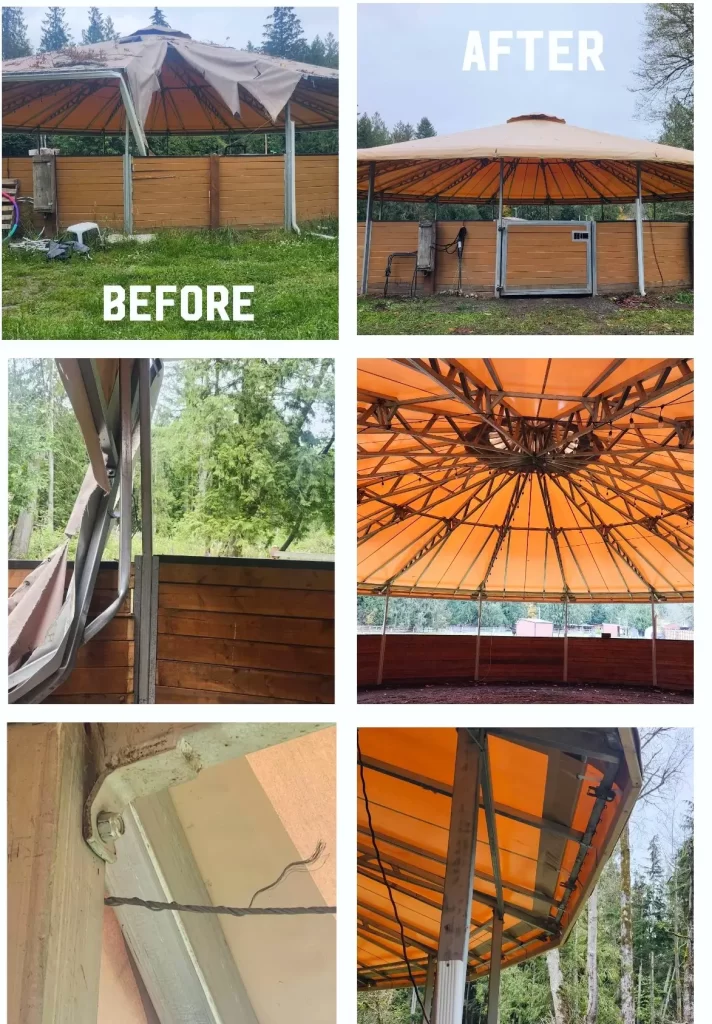Weathering the Storm: A Comparison of Traditional Agricultural Buildings and Equi-Cover Roundpen Covers in Severe Weather.
The increasing frequency and intensity of major storms across the United States bring a heightened awareness to the vulnerability of structures, particularly those housing livestock and essential agricultural operations. When the skies darken and winds howl, the integrity of these buildings becomes paramount for the safety of animals and the continuity of work. This article examines the contrasting performance of traditional agricultural buildings and Equi-Cover Roundpen Covers when faced with severe weather events, highlighting the inherent risks associated with conventional materials and the distinct advantages offered by textile-based roofing systems.
The Perils of Traditional Agricultural Buildings in High Winds:
Traditional agricultural buildings, often constructed with metal roofing panels, wooden beams, and secured with nails and screws, offer robust shelter under normal conditions. However, these very materials can become significant hazards when subjected to the extreme forces of a major storm.
Research consistently shows that high winds are a primary cause of damage to agricultural structures. Studies by organizations like the Federal Emergency Management Agency (FEMA) and various state agricultural extensions document the common types of damage:
- Roof Failure and Flying Debris: Metal roofing, while durable under normal circumstances, can peel off in large sheets when subjected to high uplift forces. These panels, often with sharp edges, become dangerous projectiles capable of causing severe lacerations and even fatal injuries to both humans and animals. Similarly, wooden components, including beams and wall sections, can be ripped apart, sending heavy and sharp debris scattering across the landscape. Nails and screws, once fasteners, transform into shrapnel.
- Structural Damage and Collapse: The force of wind can exert immense pressure on the walls and frames of traditional buildings. Weak points or inadequate anchoring can lead to partial or complete structural collapse, trapping occupants and causing further injury. The weight of fallen structural elements adds to the danger.
- Prolonged Downtime and Recovery: The aftermath of a significant storm often leaves a trail of destruction. Repairing or rebuilding damaged traditional agricultural buildings is a lengthy and complex process. Insurance claims need to be processed, contractors specializing in agricultural construction become overwhelmed and backlogged, and the procurement of specific building materials can face delays, especially in badly affected regions. This prolonged downtime can severely impact agricultural operations and the well-being of housed animals.
Equi-Cover Roundpen Covers: A Safer and More Resilient Alternative
Equi-Cover Roundpen Covers offer a fundamentally different approach to shelter, particularly in their roofing design. Utilizing high-strength textile fabric stretched over a robust frame, these structures present several key advantages when facing severe weather.
- Reduced Risk of Projectile Debris: In the event of extreme wind forces causing the fabric to tear or detach, the lightweight nature of the material significantly mitigates the risk of serious injury. Unlike heavy metal panels or splintered wood, the fabric will not become a sharp, high-velocity projectile. Cleanup is considerably safer and easier, focusing on managing a large piece of flexible material rather than scattered sharp debris.
- Minimized Structural Damage: While the fabric cover is designed to withstand significant wind loads, in truly catastrophic events where tearing occurs, the damage is typically limited to the fabric cover itself. The heavy gauge steel supporting frame, engineered for stability, is less likely to suffer major structural damage compared to the rigid framework of a traditional building under similar stress.
- Faster and Simpler Recovery: The recovery process for an Equi-Cover following storm damage is significantly streamlined. Minor tears can often be addressed on-site with readily available patch kits, allowing for a quick return to functionality. For more extensive damage, the fabric cover can be detached and shipped for professional repair, with a turnaround time measured in weeks, not the months often associated with traditional building repairs. If the fabric is beyond repair, ordering and installing a new cover is a relatively swift process, minimizing disruption to operations.
Environmental Considerations:
Textile fabrics used in Equi-Covers have a potentially lower carbon footprint in production due to their lightweight nature. The recyclability depends on the specific fabric type, with advancements being made in this area. The volume of waste from a fabric replacement is considerably less than that of a traditional roof.
Conclusion: The comparison between traditional agricultural buildings and Equi-Cover Roundpen Covers in the context of severe storms reveals a significant divergence in safety and recovery. The rigid and often heavy materials of traditional structures pose a considerable risk of dangerous projectile debris and can lead to lengthy and complex repairs following damage. In contrast, the textile fabric roofing of Equi-Covers offers a safer alternative, minimizing the risk of injury and facilitating a much faster return to operational status through simpler repair or replacement processes. As severe weather events become more prevalent, the design and materials of agricultural buildings warrant careful consideration, with innovative solutions like Equi-Covers presenting a compelling case for enhanced safety and resilience.

